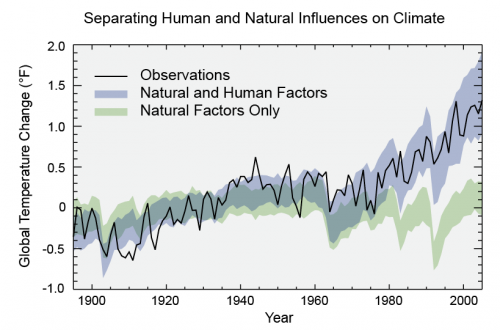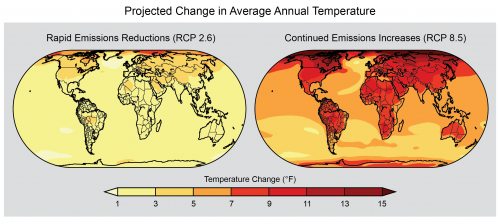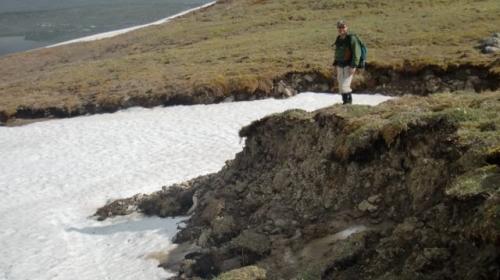This quote from John Muir helps to capture why everyone needs to care just a little bit more about the changes happening in the polar regions of the Earth.
What happens in the Arctic...
There's another great saying I learned from Dr. George Kling, a co-PI on this project. Unlike the saying "What happens in Vegas, stays in Vegas," the same is not true for the Arctic. He called it the Anti-Vegas Rule. What happens in the Arctic, does NOT stay in the Arctic.
The Arctic, and Antarctic are far from closed systems. Yes, they seems far away, and unfamiliar to most of us (though hopefully you have a better since of what it is like from reading along in my journals), but the changes going on in the polar regions have true implications for us at home, and around the world.
Climate ChangeA statistically significant variation in either the mean state of the climate or the mean variability of the climate that persists for an extended period (typically 10 years or more). Climate change may result from such factors as changes in solar activity, long-period changes in the Earth's orbital elements, natural internal processes of the climate system, or anthropogenic forcing (for example, increasing atmospheric concentrations of carbon dioxide and other greenhouse gases).
The Arctic has been a major focus of study because climatic changes have been occurring faster and to a higher degree in the Arctic versus compared to the rest of the world. I am going to focus on increasing annual temperatures, however there are other very important changes such as precipitation patterns that need to be considered as well.

The IPCC recently came out with their latest report stating that global climate change, including global warming, is happening and states that human influences are strongly connected to causing many of the changes we are seeing. You can read more of this report here.

The Arctic has seen surface temperatures increase in the past 50+ years between 2-4ºC, which is by as much as 7.2ºF! This is drastic enough that some places are seeing major reductions in amount of sea ice, and amount of snowfall.

These increases in temperature have been correlated with increased in carbon dioxide concentrations. We have clearly charted a relationship between carbon dioxide atmospheric amounts relating to temperature increases. So the problem becomes, as we release more carbon, we are going to keep increasing our temperatures.
As many of you know a major source for the carbon is from fossil fuels, when we burn gasoline in our cars we emit carbon, or when we use coal to make electricity, we release carbon. One source of carbon that we often forget, is carbon that is stored in permafrost since it is, after all, buried in the ground far from where we live.
PermafrostPermanently frozen ground., A Carbon Time Bomb

PermafrostPermanently frozen ground., if you recall from my previous journals, is like a giant slab of frozen ground that lies beneath the arctic tundra. In this frozen soil are plants, and remains of animals from hundreds to thousands of years ago. As this soil thaws those materials start to break down. One of the major contributors to this break down are microbes. Microbes will eat this organic material and release carbon dioxide (just like we eat food and then release carbon dioxide).
There are other contributors that are just as important, if not even more important in this release of carbon as well, UV sunlight. You can read more about the influence of sunlight on this carbon release from Regina Brinker’s PolarTREC expedition with Dr. Rose Cory.
It becomes very important for us to understand how this release of carbon into the atmosphere could impact each and every one of us. Because, as you recall from earlier, we said this isn't Vegas... what happens in the Arctic, DOESN'T stay in the Arctic!
PermafrostPermanently frozen ground. is estimated to contain twice as much carbon as there is currently in the atmosphere- as this melts and releases carbon it is believed that 190 billion tons of carbon could be released- since 1850, the duration of the entire human industrial age, has released only about twice that amount! (http://www.wunderground.com/resources/climate/melting_permafrost.asp)
Methane
We also have to remember that methane is another potent greenhouse gas that will also be released as the permafrost melts. Methane is a gas given off by anaerobic respiration- something certain microbes perform when oxygen isn't available. As the active layer becomes thicker, even if oxygen isn't available to microbes, they can also continue to break carbon down to make methane. Here's the bad news, methane is 30x stronger at trapping heat than carbon dioxide is! As the permafrost melts it has the potential to add sequestered carbon and methane.
It Doesn't Stay Put
The carbon (both carbon dioxide and methane) that is released in the Arctic will circulate, entering the northern hemisphere, were the United States is, within 1 year, and will further mix to impact the rest of the global atmosphere within 4 years. The potential warming associated with the carbon release will be felt worldwide. This will change ecosystems, we will be warmer in many areas, precipitation patterns will change; these in turn will change the plant life, and eventually the animal and human lifestyles as well. We need to care about what happens in the Arctic, and microbes are playing a role in those events.
PolarConnect
In case you were unable to take part in my PolarConnect web event it is now archived, you can view it here.
- < prev
- 33 of 33


Comments